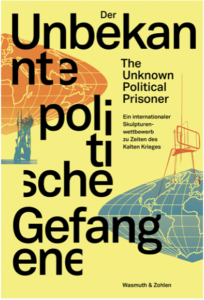30.10.2020 –
18.07.2021
THE UNKNOWN POLITICAL PRISONER – An International Sculpture Competition in the Cold War Era

The competition for the »Monument to the Unknown Political Prisoner« was probably the most important art competition of the post-war period. More than 3,000 artists from all over the world participated, including sculptors and architects such as Max Bill, Alexander Calder, Naum Gabo, Barbara Hepworth, and Bernhard Heiliger.
Like no other competition after 1945, it reflects a highly ideological art policy: within the tensions of the East-West conflict, it was announced in January 1952 by the Institute of Contemporary Arts (ICA) in London. Both the Eastern Bloc countries and the Soviet Union boycotted the competition – in all probability because they were aware that its financing had been arranged by the American Secret Service. Recent research has even conjectured that the competition was essentially directly financed by the CIA.
More than 3,000 sculptors from 57 nations worldwide responded to the announcement and submitted about 1,500 designs. With 262 submissions, the still young Federal Republic of Germany had the largest number of participants. Whereas the older, mostly figurative generation did not join in, young artists saw it as an opportunity to attract international attention. For the first time, abstract art was prominently featured as a symbol of freedom and democracy.
In order to accommodate the many submissions, the ICA organized national exhibitions and preliminary rounds in Germany, United Kingdom, France, Italy, Austria, Norway and the United States. Together with the forty-six submissions from Switzerland, the German designs were shown at the Haus am Waldsee in Berlin in 1952–53. As a result of the national preliminary rounds, 140 works were then presented at the Tate Gallery in London from March to May 1953 – an extraordinary success: more than 30,000 people attended this international exhibition that included renowned names.
The international jury chose the British sculptor Reg Butler as the winner of the competition. His design was to be erected more than 30 meters high and consisted of three components: a massive stone as a pedestal, on which stood three female figures, and a tall iron construction on three legs that resembled a watchtower.
For a significant part of the public in Germany and a little later in London as well, however, the artistic designs represented an aesthetic stress test that was almost too much to endure. Nevertheless, Ernst Reuter, the mayor of West Berlin at the time, announced, even before the final jury meeting in London, his city’s emphatic interest in being the site for installing the winning sculpture. In April 1957, the Berlin Senate resolved to erect Butler’s work on the mountain of wartime rubble in the Humboldthain Park, as a counter to the Soviet Monument in Treptower Park. These plans came to nothing in the end, however, due to resistance from the citizenry and a lack of funding. In 1964, the Senate ended this chapter once and for all – with the building of the Berlin Wall and the Cuban Missile Crisis, priorities had shifted, and with the beginning of the Willy Brandt era, rapprochement was being emphasized over further escalation and provocation.
The exhibition at the Kunsthaus Dahlem reconstructs for the first time this historically unique and ambitious competition with numerous national and international loans. In addition to the winning British design, original models from various countries, such as Iraq, Iceland, Norway and Switzerland, are also being shown as well as drawings and historical documents on the prize-winning works. The exhibition focuses particularly on all the surviving models from the German short list, which were last shown in this constellation in Berlin in 1953.
The design of the exhibition at the Kunsthaus Dahlem was based on the design that was conceived in 1952–53 for the American preliminary round in New York’s Museum of Modern Art and contrasts the architecture of the building with a decidedly modernist idiom.
Artists in the Exhibition
International Section: Ørnulf Bast, Reg Butler, Wessel Couzijn, Emil Gehrer, Gerður Helgadóttir, Barbara Hepworth, Hugo Imfeld, Lazaros Lameras, Ulrika Marseen, F. E. McWilliam, Luciano Minguzzi, Jorge Oteiza, André Ramseyer, Theodore Roszak, Jewad Selim, Jorge Vieira.
German Section: Egon Altdorf, Karl Hartung, Bernhard Heiliger, Hans Jaenisch, Franklin Pühn, Erich F. Reuter, Zoltán Székessy, Hans Uhlmann.
The exhibition was supported by the Hauptstadtkulturfonds.